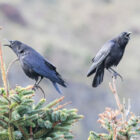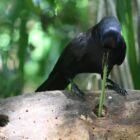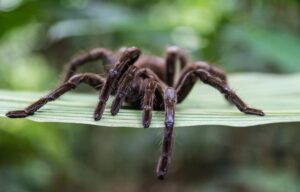How intelligent are crows?

Crows have earned a reputation as one of the most intelligent creatures in the animal kingdom. But just how intelligent are they? Let’s explore the fascinating world of corvid cognition.
Logical Crow: Problem-Solving Skills
Crows are renowned for their problem-solving abilities, which are often on par with those of primates and other highly intelligent animals. In a famous experiment conducted by researchers, crows were presented with a challenging task: they had to obtain a piece of food that was placed on a platform floating in water. To reach the food, the crows had to figure out a way to raise the water level.
After several failed attempts, the crows devised a clever solution. They began to drop stones into the water, observing that each stone they dropped raised the water level slightly. With this newfound understanding of cause and effect, the crows continued to drop stones until the water level had risen enough for them to reach the food. This behavior demonstrates an impressive level of intelligence, as it requires the ability to understand cause and effect and to use this knowledge to solve a problem.
Furthermore, this experiment highlights the crows’ ability to learn and adapt to new situations. Despite initially failing to reach the food, the crows persisted and eventually discovered a solution. This ability to learn from past experiences and apply that knowledge to new situations is a key aspect of intelligence.
Tool Use and Innovation
Crows’ ability to use tools is a testament to their intelligence and adaptability. In a classic experiment, researchers placed a piece of food out of reach of the crows, along with a stick that could be used as a tool. The crows quickly learned to use the stick to retrieve the food, demonstrating their ability to use tools to solve problems.
This behavior is not limited to captive crows. Wild crows have been observed using tools in their natural environment. For example, they have been seen using sticks to extract insects from tree bark, or using leaves as makeshift umbrellas to shield themselves from rain.
New Caledonian Crows
New Caledonian crows (Corvus moneduloides) have been observed using tools in the wild in a variety of creative ways. They are known to find small twigs and use them to probe holes in logs, extracting insects and larvae as a source of food. Additionally, these intelligent birds can manufacture tools by breaking twigs off bushes and trimming them to produce functional stick tools. The ability to manufacture tools is considered a higher level of cognitive function compared to simple tool use.
These resourceful crows are also capable of making leaf tools by tearing rectangular strips off the edges of Pandanus spp. leaves. This allows them to exploit naturally occurring hooks, such as the barbs running along the edges of these leaves, which can be used as hooks if the tool is held with the barbs pointing towards the crows’ head.
Moreover, these birds have been observed incorporating other naturally occurring hooks into their tools, such as the thorns that grow on vine species in New Caledonia. They create hooks by crafting both wood and ferns into hooks, trimming the junctions between two branches or fern stolons into a tick shape, and then removing material from this junction to create a functioning hook.
This process of imposing three-dimensional form onto a natural material resembles carving and showcases the crows’ remarkable problem-solving abilities and adaptability.
“Murders” and Social Intelligence
Crows are not only intelligent problem solvers but also highly social creatures. Their advanced social intelligence is evident in the way they interact and cooperate with other members of their species.
In the wild, crows often form tight-knit family groups known as “murders”, that work together to find food, protect their territory, and raise their young. Within these groups, crows have been observed engaging in complex behaviors, such as using coordinated tactics to steal food from larger predators or working together to scavenge for food in urban environments.
Crows are also known for their ability to communicate and share information with other members of their group. They use a variety of vocalizations and body language to convey different messages, such as warning calls to alert others of potential danger or food calls to signal the presence of food.
One of the most fascinating aspects of crow social intelligence is their ability to recognize and remember individual humans. Crows have been observed to react differently to different people, depending on their past interactions with them. They may scold or mob people who have harmed them or their group in the past, while showing more friendly behavior towards those who have been kind to them.
Memory and Planning
Crows have an impressive capacity for memory and planning. They have been observed to remember the locations of food caches for extended periods, sometimes up to six months. This is an essential skill for their survival, as crows often scatter their food in different locations to prevent theft by other animals.
In one study, researchers found that crows would revisit their food caches even after several months, retrieving them when needed. This demonstrates their ability to plan ahead and remember specific locations, even when they are not immediately visible.
Additionally, crows have been observed to use tools to solve problems and obtain food. This requires not only the ability to recognize the utility of the tool but also to remember where it was last used and how it can be used in the future. This suggests that crows have a sophisticated understanding of cause and effect, a key component of intelligence.
New Caledonian crows were given a series of tricky problems where each step wasn’t visible from the others. They had to figure out how to avoid a fake tool that didn’t work or a real tool that was in a non-working machine.
The crows were smart enough to keep track of where the tools and machines were even when they couldn’t see them. They used this knowledge to plan and carry out a sequence of actions with the tools. This shows that birds can plan ahead and think about several steps at once when using tools.
Emotional Intelligence in Crows
Crows are also capable of displaying emotional intelligence. They have been observed comforting each other after a stressful event, such as a predator attack or the death of a member of their group.
When faced with a stressful situation, such as a predator attack or the presence of a threatening human, crows have been observed to display behaviors that indicate a level of empathy and support for one another. They may gather around an injured or stressed member of their group, offering vocalizations and even physical comfort.
Crows have also been observed to display behaviors that suggest a level of understanding and response to death. When a member of their group dies, crows may gather around the body, vocalizing and seemingly mourning the loss. They may also engage in what appears to be a form of funeral ritual, with other crows joining in the vocalizations and even touching or pecking at the body.
The Remarkable Intelligence of Crows
Crows are highly intelligent creatures with a wide range of cognitive abilities. From problem-solving and tool use to social and emotional intelligence, crows demonstrate a level of intelligence that rivals that of many other animals, including primates.










